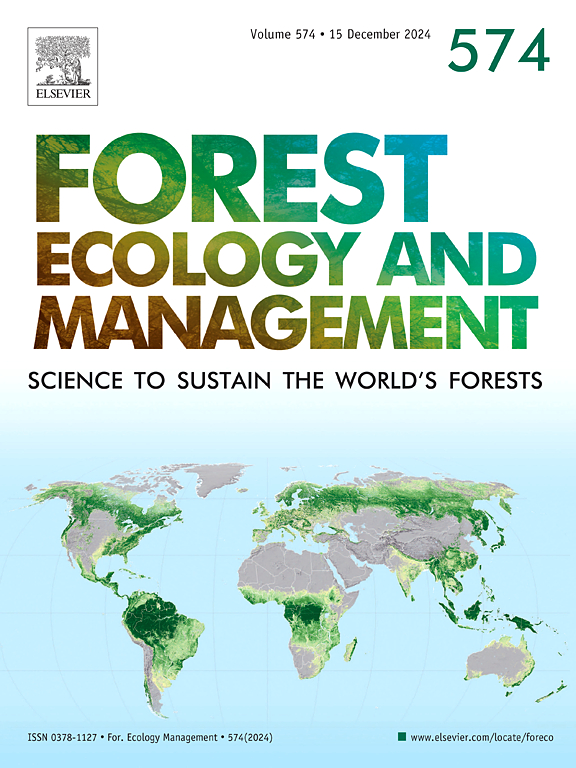Heat tolerance of temperate tree species from Central Europe
IF 3.7
2区 农林科学
Q1 FORESTRY
引用次数: 0
Abstract
Climate-change induced tree mortality or productivity declines have (if not mediated by herbivory, pathogens or fire) mostly been attributed to drought stress. Although the importance of drought is undisputed, evidence is accumulating that the role of heat stress as a separate factor has been underestimated. The photosystem II (PS II) is known to be particularly sensitive to heat and its functionality can be easily tracked with chlorophyll fluorescence analysis. Several recent studies have substantiated species-specific differences in heat tolerance based on reductions of the maximum quantum yield (Fv/Fm) of PS II. However, these seminal studies were based on short-term heat exposures for 15 or 30 min, which often resulted in unrealistically high critical temperatures compared to ambient conditions even under climate change. Therefore, we tested the feasibility of heat treatments of up to 4 h, which comes closer to the duration of daily heat maxima in the noon and afternoon hours in 14 temperate tree species native or introduced to Central Europe. Critical reductions in Fv/Fm occurred after 4 h of heat at lower temperatures compared to short-term experiments. While all species coped well with 35 °C, reductions in Fv/Fm started to occur in some species at leaf temperatures of 40 °C and were widespread at 45 °C. Broadleaved trees were generally more tolerant to heat than conifers. Though heat tolerance was correlated with drought tolerance, deviations from the regression line showed that these factors have to be regarded as independent factors when assessing the climate change sensitivity of tree species.
中欧温带树种的耐热性
气候变化引起的树木死亡或生产力下降(如果不是由草食、病原体或火灾介导的话)主要归因于干旱胁迫。尽管干旱的重要性是无可争议的,但越来越多的证据表明,热应激作为一个单独因素的作用被低估了。众所周知,光系统II (PS II)对热特别敏感,其功能可以很容易地通过叶绿素荧光分析来追踪。最近的几项研究证实了基于PS II最大量子产率(Fv/Fm)降低的物种耐热性差异。然而,这些开创性的研究是基于15或30 min的短期热暴露,即使在气候变化的情况下,与环境条件相比,这往往导致不切实际的高临界温度。因此,我们测试了高达4 h的热处理的可行性,这更接近中欧本地或引进的14种温带树种中午和下午的每日最高热量持续时间。与短期实验相比,在较低温度下加热4 h后,Fv/Fm发生了临界降低。虽然所有物种都能很好地应对35°C,但在叶温为40°C时,一些物种的Fv/Fm开始下降,并在45°C时广泛存在。阔叶树一般比针叶树更耐热。尽管耐热性与耐旱性存在相关性,但与回归线的偏差表明,在评估树种的气候变化敏感性时,这些因素必须作为独立的因素来考虑。
本文章由计算机程序翻译,如有差异,请以英文原文为准。
求助全文
约1分钟内获得全文
求助全文
来源期刊

Forest Ecology and Management
农林科学-林学
CiteScore
7.50
自引率
10.80%
发文量
665
审稿时长
39 days
期刊介绍:
Forest Ecology and Management publishes scientific articles linking forest ecology with forest management, focusing on the application of biological, ecological and social knowledge to the management and conservation of plantations and natural forests. The scope of the journal includes all forest ecosystems of the world.
A peer-review process ensures the quality and international interest of the manuscripts accepted for publication. The journal encourages communication between scientists in disparate fields who share a common interest in ecology and forest management, bridging the gap between research workers and forest managers.
We encourage submission of papers that will have the strongest interest and value to the Journal''s international readership. Some key features of papers with strong interest include:
1. Clear connections between the ecology and management of forests;
2. Novel ideas or approaches to important challenges in forest ecology and management;
3. Studies that address a population of interest beyond the scale of single research sites, Three key points in the design of forest experiments, Forest Ecology and Management 255 (2008) 2022-2023);
4. Review Articles on timely, important topics. Authors are welcome to contact one of the editors to discuss the suitability of a potential review manuscript.
The Journal encourages proposals for special issues examining important areas of forest ecology and management. Potential guest editors should contact any of the Editors to begin discussions about topics, potential papers, and other details.
 求助内容:
求助内容: 应助结果提醒方式:
应助结果提醒方式:


